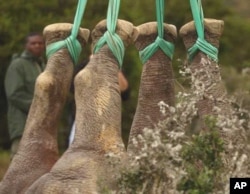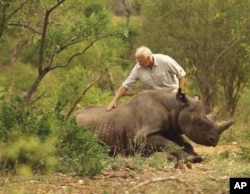In November last year, the residents of a rural area in South Africa’s KwaZulu-Natal province witnessed a surprising sight. High above their heads, silhouetted against an azure sky, suspended upside down by its legs and dangling from ropes below a speeding helicopter, was a blindfolded rhinoceros.
On that particular day, this scene repeated itself a number of times, as a team of dedicated conservationists transported 19 rare black rhinos to an area where it’s hoped they’ll soon begin breeding.
“We took those rhinos from an area where they needed to be reduced, to keep that population breeding adequately. So we were taking them from an area of high density to a new area, to create a new population of black rhino,” said Dr. Jacques Flamand, an internationally respected wildlife veterinarian and the head of the World Wildlife Fund’s Black Rhino Range Expansion Project.
According to the WWF, there are only about 4,800 of the animals left in Africa, about 1,900 of them in South Africa. There are also a few black rhinos in zoos around the world.
The creatures remain critically endangered – not the least because poachers are killing them and their bigger white rhino cousins for their horns. The South African government says criminals killed more than 1,000 rhinos in the country in the past five years – and almost 450 in 2011 alone.
The poaching epidemic is driven by the scientifically disproven belief that ground rhino horn cures cancer. It fetches very high prices on the black market in Asia.
Seven new rhino populations
The WWF said black rhinos were relatively common across Africa until the 1960s. “Wildlife used to be so plentiful that people thought animals like black rhino were a limitless resource,” said Flamand. “So they shot so many. I remember in East Africa when I was a child people were shooting rhino just for sport. That was part of the (black rhino’s) decline.”
He continued, “More importantly was a loss of habitat – more and more people encroaching onto their land and pushing them out. They’re not very tolerant of disturbance.”
Flamand has worked as a veterinarian and government wildlife advisor across Africa, Asia and the Middle East. His project to increase black rhino numbers in South Africa began in 2003. He maintained there weren’t enough suitable areas in the country to hold the animals.
“This project was designed to try and address that by entering into partnerships with other landowners – not necessarily landowners traditionally involved in conservation – to find land that would be able to harbor black rhino,” he said.
To find the very big tracts of land that black rhino need in order to thrive, and especially in South Africa’s Zululand region, was always a challenge, Flamand told VOA.
“What we needed were areas that could harbor a population of at least 50 black rhino (each). And that, in Zululand for instance, translates to about 200 square kilometers – and nobody had farms that size,” he said, explaining further, “So through a lot of hard work we’ve succeeded in getting landowners to join their properties to create the very big areas that black rhino need.”
The landowners, helped by the WWF, took down the many fences on their properties that would have hindered rhino movements – and therefore breeding. In so doing, the large areas needed by black rhino were formed.
“To date we’ve been successful in creating seven such areas and there are more in the pipeline. We’ve released seven new populations of black rhino in the hope that they’re going to breed successfully,” said Flamand.
The new populations of black rhino are made up of a total of 120 animals. Landowners participating in the project are implementing extremely tight security systems on their ranches to keep the rhinos safe from poachers.
Rhinos a ‘liability’ because of poaching
Flamand agreed that the mere presence of rhino on land in South Africa ensured that the property could be targeted by criminals trying to get their hands on the animals’ valuable horns. “A lot of people don’t want rhino (on their land) because they’ve become a liability with the poaching, and that is a problem,” the wildlife veterinarian acknowledged.
He added that even in the absence of poaching, rhinos are a “hard sell.” Flamand explained that there are “very few” immediate benefits for landowners of having black rhino on their land, unless the owners are “into tourism and can use black rhino as a marketing tool.… But some landowners aren’t in the tourism industry.…”
Nevertheless, he and the WWF have succeeded in persuading a number of South African ranchers of the conservation benefits of hosting populations of black rhinos.
“The key to getting adequate land is finding a champion in that block of land who carries the project for you,” Flamand emphasized. Those “champions” he said then persuade other landowners of the long-term worthiness of the project in protecting one of South Africa’s famous Big Five game animals.
Helicopter transport safer for rhinos
In explaining the latest relocation of 19 black rhino, when the animals were airlifted by helicopter to a suitable area of KwaZulu-Natal, Flamand said it had been “very difficult to pull off…. First of all, we had a lot of different organizations participating in the capture. It was a huge army of people – from veterinarians to veterinary technicians to drivers, laborers and so on.”
The black rhinos are darted and sedated by experts. “While they are sleeping we hitch them up (to a helicopter). So they are fast asleep and they don’t know what’s going on.”
Ultra-strong ropes are then tied around the rhinos ankles. “This technique of lifting them by the ankles is proving very popular with vets because it doesn’t hurt the animal and it’s very effective and quick,” said Flamand.
Black rhinos commonly weigh about two tons, but Flamand said transporting them by helicopter rather than by huge trucks is much more effective because it is much faster, which also means the animals are sedated for shorter periods of time. Veterinarians say the longer an animal is under sedation, the greater its chance of dying.
Flamand said all possible measures were taken to ensure the rhinos’ safety and well-being. “When we finally do wake them up, they don’t know what they’ve been through at all, so there’s absolutely no trauma associated with this…. The rhinos were accompanied all the way by a vet so we could be sure that they had the best possible care during the trip and at the release as well.”
Wild dogs also benefit
Flamand said his project’s major achievement has been to increase the range of black rhino in Southern Africa, thereby laying the foundation to greatly boost the animal’s numbers in the future and prevent its extinction.
He added, “Of course this doesn’t directly address the poaching issue but we are helping in this regard by getting rhino to breed faster.”
Flamand also stressed that the initiative benefits other endangered wildlife, since they too now have more safe land available to them on which to breed. “It’s not only good for black rhino; it’s good for elephants and vultures and especially (for) other critically endangered species like the wild dog,” he pointed out.
Flamand said wild dogs, once near extinction, are now “increasing very well” as a result of also settling on the new black rhino conservation areas.
“The wild dogs now also have larger spaces available to them and can roam freely without encountering fences every few kilometers,” he said.
People trying to prevent the extinction of black rhinos describe Flamand’s project as one of the greatest-ever African conservation success stories.














